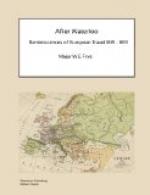The Feld-zeichen of Hesse-Cassel is green and red. After passing thro’ Hanau, where we halted three hours, which gave me an opportunity of viewing the field of battle there, we proceeded to Frankfort and arrived there at twelve o’clock the 12th of March. I put up at the Swan inn. In summer time the country about Fulda and in general between Fulda and Frankfort must be very pleasing from the variety of the features of the ground. We lived very well and very cheap on the road. The price of the diligence from Leipzig to Frankfort was eleven Reichsthaler.
After remaining three days to repose at Frankfort I took my place to Mayence and from thence to Metz and Paris. In the diligence from Mayence and indeed all the way to Paris I found a very amusing society. There were two physicians and M. L[emaitre], a most entertaining man and of inexhaustible colloquial talent; for, except when he slept, he never ceased to talk. His conversation was however always interesting and entertaining, for he had figured in the early part of the French Revolution and was well known in the political and litterary world as the editor of a famous journal called Le Bonhomme Richard.[129]
Metz is a large, well built and strongly fortified city. Verdun, thro’ which we passed, became quite an English colony during the war from the number of detenus of that nation who were compelled to reside there. At Epernay we drank a few bottles of Champagne and a toast was given by one of the company, which met with general applause. It was Bon voyage to the Allies who have now finally evacuated France to the great joy of the whole nation, except of the towns where they were cantoned, where they contributed much towards enriching the shopkeepers and inhabitants.
I remained in Paris six days and then proceeded to England.
[129] Le bonhomme Richard aux bonnes gens was
not a “famous journal,” as
only two numbers appeared
in 1790 (M. Tourneux, Bibliographie de
l’histoire de Paris
pendant la Revolution, vol. 11, p. 585, n. 10,
511). The publisher,
Antoine-Francois Lemaitre, whom Major Erye
mentions in this passage,
was the author of some other revolutionary
pamphlets, e.g., Lettres
bougrement patriotiques, etc.—ED.
INDEX
Acheron, Lake.
Adam, Major-General commands Light Brigade of General
Sir H. Clinton’s
division.
Aix-la-Chapelle:
Hotel-de-Ville;
Cathedral; relics of Charlemagne;
Napoleon’s benefactions; overbearing
demeanour of Prussian soldiers;
Faro bank; interesting Tyrolese girl; baths.
Albanot Villa Doria, ancient monument.
Albany, Countess of, her claim to be the legitimate
Queen of England;
Alfieri’s attachment to.
Alexandria: Austrian Government destroys fortifications
of
Alfieri: compared with Shakespeare, Schiller,




